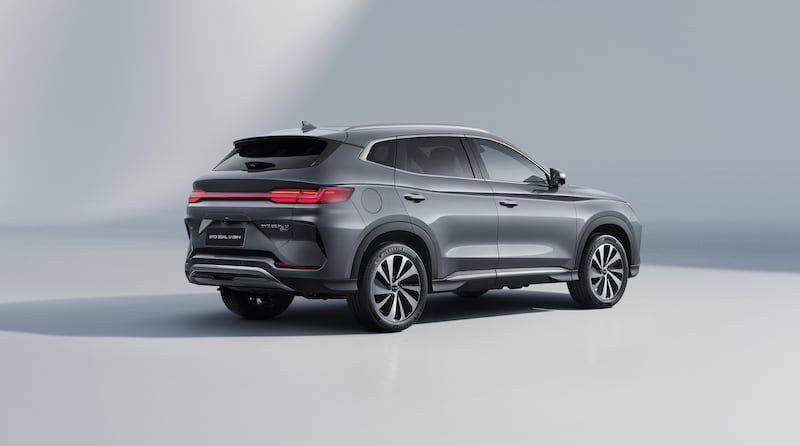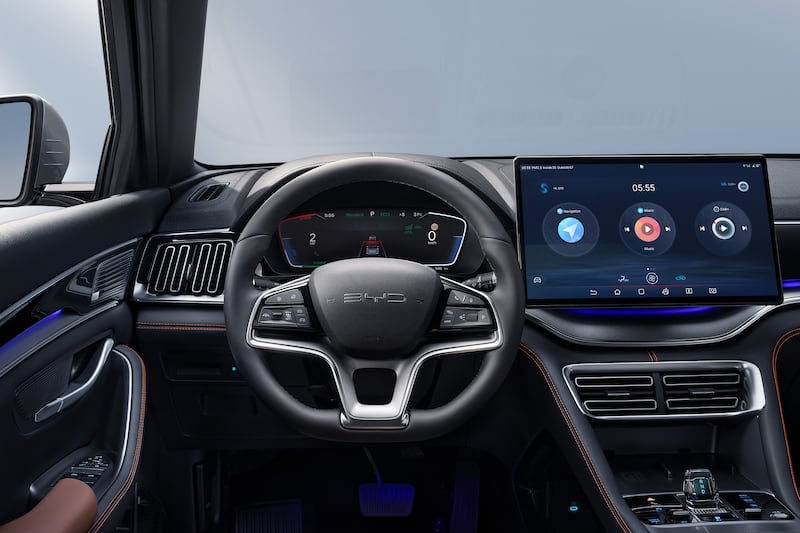It is tipping down so hard with rain that the track officials have put out cones, not to indicate braking and turn-in points but to show us where the deepest standing water is, so that we can swerve around it. It’s the kind of weather that would have Formula One officials sending out the safety car for a few desultory laps before deciding that it’s too dangerous to drive, and that the weekend is a washout.
However, with a flash of amber lights, our own safety car wanders out on to the track and heads off down the front straight with us in tow. And he’s not hanging about either, in spite of the fact that the South China Sea is apparently trying to dump its entire watery mass on this particular corner of the world.
That corner is a tiny go-kart track to the northwest of the massive metropolis of Shenzhen, a city of 18 million people and an inexhaustible supply of skyscrapers. It’s home to Build Your Dreams, or BYD, the big Chinese car maker that hit the Irish market last year with three electric cars: the Atto 3 crossover, the Dolphin hatchback, and the Seal saloon. Slightly silly names apart, all three are seriously impressive cars, not least thanks to their robust, long-ranged Blade batteries, which use lithium-iron phosphate chemistry – sturdier and longer-lived than conventional lithium-ion batteries.
The car we’re splashing out on to the sodden racetrack is the second member of the Seal family, given the slightly dowdy name of Seal-U. It filches a couple of design details from its lower-slung brother, such as the C-shaped LED headlights, but it’s a much taller, bulkier, somewhat blander SUV instead of the sleekly appealing four-door saloon. Still, SUVs are what people want, and this one is pleasingly practical, with roomy back seats and a decent 552-litre boot.

The interior is nicely laid out, and feels well-made on this first impression. There’s the same rotating 15-inch screen in the centre of the dashboard (which really needs a software upgrade to make it less fiddly to use) and the same neat crystal-like gear selector that you get in the Seal saloon.

The digital instruments are larger and clearer though, and now mounted under a classy-looking leatherette-covered binnacle rather than just having a free-standing screen, while the new three-spoke steering wheel also looks and feels more suitably expensive than the one from the Seal saloon.
It’s also a plug-in hybrid. That may seem like something of a retrograde step for a car maker that prides itself on its high-tech batteries (BYD began life as a battery maker and only expanded into car making in 2005) but Stella Li, the head of BYD Europe and one of the most senior and long-serving executives in the company batted away such potential criticisms, pointing out that the current droop in electric car sales being seen around the world is indicative that the majority of buyers don’t trust the technology and would rather wait and see before taking the electric leap.
[ Our Test Drive: Renault ScenicOpens in new window ]
Thus BYD is launching a whole new range of plug-in hybrid models badged DM-i, which are based around a 1.5-litre petrol engine and large batteries giving a usefully long electric range, but with the reassurance of petrol power and fuel tank for when you need to do a longer journey. Li claims BYD’s experience in China shows that 80 per cent of the buyers of such cars subsequently trade up to a full EV – and that there will be full EV.
That remains to be seen, but this Seal-U DM-i combines a 109hp petrol engine with a 197hp electric motor, and an 18.3kWh battery. That gives it, claims BYD, an electric range on a full charge exceeding 100km (although that’s based on the Chinese official test, which generally produces more optimistic figures than the European WLTP test, flawed and all as it is) and a total combined petrol and electric range topping 1,000km. That should put any range anxiety to bed.
Performance is pleasingly brisk, with the Seal-U able to crack the 0-100km/h sprint in 5.9 seconds, and on this particular racetrack, that feels more than quick enough for today. Road cars generally feel all at sea on a track, but the Seal-U actually deports itself pretty well.
The steering is light, but direct and while the inevitable scrubby understeer sets in on the tighter corners, it feels far more controlled and composed than you might expect. We can’t be sure of the ride quality, thanks to the smoothness of the track, but a few wheels dropped on to the ridged kerbs at the track’s edges didn’t set the wheels thumping and bumping, so hopefully that’s a good sign.
The Seal-U should arrive in Ireland this autumn in this hybrid form, with the full-electric versions following on behind. We haven’t had enough time with it to do more than skim the surface of what merits and demerits it may have, but it seems like a competent, well-rounded SUV on this basis, and if BYD’s pricing is as sharp as it tends to be, then it could well prove a good foil for the likes of the Toyota RAV4 PHEV and the Peugeot 3008 hybrid.
[ Our Test Drive: Mercedes-Benz E300eOpens in new window ]
- Sign up for push alerts and have the best news, analysis and comment delivered directly to your phone
- Find The Irish Times on WhatsApp and stay up to date
- Listen to our Inside Politics podcast for the best political chat and analysis










